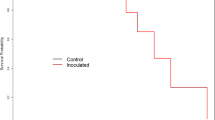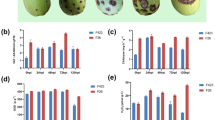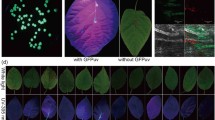Abstract
Paulownia witches’ broom is arisen from the invasion of an obligatory parasitic bacteria-phytoplasma, which can result in huge economic losses of Paulownia trees. The mechanism of the occurrence of this disease has been studied extensively. However, its pathogenesis is still poorly understood. Here, whole transcriptome strand-specific RNA sequencing was performed to identify long noncoding RNAs (lncRNAs) that referred to phytoplasma infection in Paulownia. In all, 2725 lncRNAs were identified and 748 of them were considered to be differentially expressed. KEGG pathway analysis showed the predicted target genes of these 748 lncRNAs participated mainly in lignin biosynthesis pathway, plant–pathogen interaction pathway and plant hormone signal transduction pathway, which indicated that lncRNAs may be closely related to the occurrence of witches’ broom. The results provide new perspective into the function of lncRNAs in Paulownia and potentially in other trees in answering phytoplasma invasion.





Similar content being viewed by others
References
Ates S, Ni YA, Tozluoglu M (2008) A Characterization and evaluation of Paulownia elongata as a raw material for paper production. Afr J Biotechnol 7(22):4153–4158
Ben AB, Wirth S, Merchan F et al (2008) Novel long non-protein coding RNAs involved in Arabidopsis differentiation and stress responses. Genome Res 19(1):57–69
Bernstein E, Allis CD (2005) RNA meets chromatin. Gene Dev 19(14):1635–1655
Boerner S, McGinnis KM (2012) Computational identification and functional predictions of long noncoding RNA in Zea mays. PLoS One 7(8):e43047
Boller T (2005) Peptide signalling in plant development and self/nonself perception. Curr Opin Cell Biol 17(2):116–122
Brosnan CA, Voinnet O (2009) The long and the short of noncoding RNAs. Curr Opin Cell Biol 21(3):416–425
Cabili MN, Trapnell C, Goff L et al (2011) Integrative annotation of human large intergenic noncoding RNAs reveals global properties and specific subclasses. Gene Dev 25(18):1915–1927
Cao X, Fan G, Deng M et al (2014a) Identification of genes related to Paulownia witches’ broom by AFLP and MSAP. Int J Mol Sci 15(8):14669–14683
Cao X, Fan G, Deng M et al (2014b) Morphological changes of Paulownia seedlings infected phytoplasmas reveal the genes associated with witches’ broom through AFLP and MSAP. PLoS One 9(11):e112533
Cao X, Fan G, Dong Y et al (2017) Proteome profiling of Paulownia seedlings infected with phytoplasma. Front Plant Sci. https://doi.org/10.3389/fpls.2017.00342
Chen J, Quan M, Zhang D (2015) Genome-wide identification of novel long non-coding RNAs in Populus tomentosa tension wood, opposite wood and normal wood xylem by RNA-seq. Planta 241(1):125–143
Csorba T, Questa JI, Sun Q et al (2014) Antisense COOLAIR mediates the coordinated switching of chromatin states at FLC during vernalization. Proc Natl Acad Sci 111(45):16160–16165
Ćurković PM (2008) Auxin-treatment induces recovery of phytoplasma-infected periwinkle. J Appl Microbiol 105(6):1826–1834
Dixon RA, Achnine L, Kota P (2002) The phenylpropanoid pathway and plant defence-a genomics perspective. Mol Plant Pathol 3(5):371–390
Doi Y, Ternaka M, Yora K (1967) Mycoplasma or PLT-group-like microorganisms found in the phloem elements of plants infected with mulberry dwarf, potato witches’ broom, aster yellows and Paulownia witches’ broom. Jpn J Phytopathol 33(4):259–266
Durrant WE, Dong X (2004) Systemic acquired resistance. Annu Rev Phytopathol 42:185–209
Fan G, Dong Y, Deng M et al (2014) Plant-pathogen interaction, circadian rhythm, and hormone-related gene expression provide indicators of phytoplasma infection in Paulownia fortunei. Int J Mol Sci 15(12):23141–23162
Fan G, Cao X, Niu S et al (2015a) Transcriptome, microRNA, and degradome analyses of the gene expression of Paulownia with phytoplamsa. BMC Gen 16(1):896
Fan G, Cao X, Zhao Z et al (2015b) Transcriptome analysis of the genes related to the morphological changes of Paulownia tomentosa plantlets infected with phytoplasma. Acta Physiol Plant 37(10):202
Fan G, Xu E, Deng M et al (2015c) Phenylpropanoid metabolism, hormone biosynthesis and signal transduction-related genes play crucial roles in the resistance of Paulownia fortunei to paulownia witches’ broom phytoplasma infection. Genes Genom 37(11):913–929
Fan G, Cao Y, Deng M et al (2017) Identification and dynamic expression profiling of microRNAs and target genes of Paulownia tomentosa in response to Paulownia witches’ broom disease. Acta Physiol Plant 39(1):28
Gai Y, Han X, Li Y et al (2014) Metabolomic analysis reveals the potential metabolites and pathogenesis involved in mulberry yellow dwarf disease. Plant, Cell Environ 37(6):1474–1490
Gundersen DE, Lee IM (1996) Ultrasensitive detection of phytoplasmas by nested-PCR assays using two universal primer pairs. Phytopathol mediterr 35(3):144–151
Hisami Y, Tomomi S, Kazunoir T et al (2001) The arabidopsis AHK4 histidine Kinase is a cytokinin-binding receptor that transduces cytokinin signals across the membrane. Plant Cell Physiol 42(9):1017–1023
Hu WJ, Kawaoka A, Tsai CJ et al (1998) Compartmentalized expression of two structurally and functionally distinct 4-coumarate:CoA ligase genes in aspen (Populus tremuloides). PNAS 95(9):5407–5412
Jia H, Osak M, Bogu GK (2010) Genome-wide computational identification and manual annotation of human long noncoding RNA genes. RNA 16(8):1478–1487
Jone P (2001) Phytoplasma plant pathogens. In: Waller (ed) Plant Pathologists Pocketbook, 3rd end. CAB international, Harpenden, Hertfordshire, pp. 126–129
Jones JDG, Dangl JL (2006) The plant immune system. Nature 444(7117):323–329
Kapranov P, Cheng J, Dike S et al (2007) RNA maps reveal new RNA classes and a possible function for pervasive transcription. Science 316(5830):1484–1488
Kong L, Zhang Y, Ye ZQ et al (2007) CPC: assess the protein-coding potential of transcripts using sequence features and support vector machine. Nucleic Acids Res 35(suppl 2):345–349
Kornblihtt AR (2014) A long noncoding way to alternative splicing in plant development. Dev Cell 368(30):117–119
Kunze G, Zipfel C, Robatzek S et al (2004) The N terminus of bacterial elongation factor Tu elicits innate immunity in Arabidopsis plants. Plant Cell 16(12):3496–3507
Li J (2013) Analysis of Alternative splicing in whole transcriptome and its regulator SR protein under drought stress in seed of Zea mays. Dissertation, Zhengzhou University
Li J, Wu B, Xu J et al (2013) Genome-wide identification and characterization of long intergenic non-coding RNAs in Ganoderma lucidum. PLoS One 9(6):e99442
Li J, Zhou B, Zhu Q et al (2017) Noncoding and coding transcriptome analysis reveals the regulation roles of long noncoding RNAs in fruit development of hot pepper (Capsicum annuum L.). Plant Growth Regul 83(1):141–156
Liu J, Jung C, Xu J et al (2012) Genome-wide analysis uncovers regulation of long intergenic noncoding RNAs in Arabidopsis. Plant Cell 24(11):4333–4345
Liu R, Dong Y, Fan G et al (2013) Discovery of genes related to witches broom disease in Paulownia tomentosa × Paulownia fortunei by a de Novo assembled transcriptome. PLoS ONE 8(11):e80238
Lucia FD, Dean C (2010) Long non-coding RNAs and chromatin regulation. Curr Opin Plant Biol 14(2):168–173
Lukiw WJ, Handley P, Wong L (1992) BC200 RNA in normal human neocortex, non-Alzheimer dementia (NAD), and senile dementia of the Alzheimer type (AD). Neurochem Res 17(6):591–597
Marquez Y, Brown JWS, Simpson C et al (2012) Transcriptome survey reveals increased complexity of the alternative splicing landscape in Arabidopsis. Genome Res 22(6):1184–1195
Mastrangelo AM, Marone D, Laidò G et al (2012) Alternative splicing: enhancing ability to cope with stress via transcriptome plasticity. Plant Sci 185–186(4):40–49
Mercer TR, Dinger ME, Mattick JS (2009) Long non-coding RNAs: insights into functions. Nat Rev Genet 10(3):155–159
Mishina TE, Zeier J (2007) Pathogen-associated molecular pattern recognition rather than development of tissue necrosis contributes to bacterial induction of systemic acquired resistance in Arabidopsis. Plant J 50(3):500–513
Mohammadin S, Edger PP, Pires JC et al (2015) Positionally-conserved but sequence-diverged: identification of long non-coding RNAs in the Brassicaceae and Cleomaceae. BMC Plant Biol 15(1):217
Morin RD, O’Connor MD, Griffith M et al (2008) Application of massively parallel sequencing to microRNA profiling and discovery in human embryonic stem cells. Genome Res 18(4):610–621
Mou Z, Fan W, Dong X (2003) Inducers of plant systemic acquired resistance regulate NPR1 function through redox changes. Cell 113(7):935–944
Mou H, Lu J, Zhu S et al (2013) Transcriptomic analysis of paulownia infected by paulownia witches’-broom phytoplasma. PLoS One 8(10):e77217
Muthusamy M, Uma S, Backiyarani S et al (2015) Genome-wide screening for novel, drought stress-responsive long non-coding RNAs in drought-stressed leaf transcriptome of drought-tolerant and -susceptible banana (Musa spp.) cultivars using Illumina high-throughput sequencing. Plant Biotechnol Rep 9(5):279–286
Namba S (2002) Molecular biological studies on phytoplasmas. J Gen Plant Pathol 68(3):257–259
Nawrocki EP, Kolbe DL, Eddy SR (2009) Infernal 1.0: inference of RNA alignments. Bioinformatics 25(10):1335–1337
Newman S, Bennett K, Wu Y (1998) Performance of maize, beans and ginger as in Paulownia plantations in China. Agroforestry Syst 39(1):23–30
Niu S, Fan G, Deng M et al (2016) Discovery of microRNAs and transcript targets related to witches’ broom disease in Paulownia fortunei by high-throughput sequencing and degradome approach. Mol Genet Genom 291(1):181–191
Ponting CP, Oliver PL, Reik W (2009) Evolution and functions of long noncoding RNAs. Cell 136(4):629–641
Rinn JL, Chang HY (2012) Genome regulation by long noncoding RNAs. Annu Rev Biochem 81:145–166
Schmittgen TD, Livak KJ (2008) Analyzing real-time PCR data by the comparative C(T) method. Nat Protoc 3(6):1101
Sugio A, Hogenhout SA (2012) The genome biology of phytoplasma: modulators of plants and insects. Curr Opin Microbiol 15(3):247–254
Suzuki T, Miwa K, Ishikawa K et al (2001) The Arabidopsis sensor His-kinase, AHk4, can respond to cytokinins. Plant Cell Physiol 42(2):107–113
Swiezewski S, Liu F, Magusin A et al (2009) Cold-induced silencing by long antisense transcripts of an Arabidopsis Polycomb target. Nature 462(7274):799–802
Szcześniak MW, Rosikiewicz W, Makałowska I (2015) CANTATAdb: a collection of plant long non-coding RNAs. Plant Cell Physiol 57(1):e8
Tian J, Song Y, Du Q et al (2016) Population genomic analysis of gibberellin-responsive long non-coding RNAs in Populus. J Exp Bot 67(8):2467–2482
Trapnell C, Roberts A, Goff L et al (2012) Differential gene and transcript expression analysis of RNA-seq experiments with TopHat and Cufflinks. Nat Protoc 7(3):562–578
Wang K, Chang H (2011) Molecular mechanisms of long noncoding RNAs. Mol Cell 43(6):904–914
Wang M, Zhang X, Liu JH (2015) Deep sequencing-based characterization of transcriptome of trifoliate orange (Poncirus trifoliata (L.) Raf.) in response to cold stress. BMC genomics 16(1):555
Wang Z, Liu W, Fan G et al (2017) Quantitative proteome-level analysis of paulownia witches’ broom disease with methyl methane sulfonate assistance reveals diverse metabolic changes during the infection and recovery processes. Peer J. https://doi.org/10.7717/peerj.3495
Weintraub P, Beanland L (2006) Insect vectors of phytoplasmas. Annu Rev Entomol 51(51):91–111
Weintraub PG, Jones P (2010) Phytoplasmas: genomes. Plant Hosts and Vectors, Wallingford
Wierzbicki AT (2012) The role of long non-coding RNA in transcriptional gene silencing. Curr Opin Plant Biol 15(5):517–522
Xin M, Wang Y, Yao Y et al (2011) Identification and characterization of wheat long non-protein coding RNAs responsive to powdery mildew infection and heat stress by using microarray analysis and SBS sequencing. BMC Plant Biol 11(1):61
Yoon JH, Abdelmohsen K, Gorospe M (2013) Posttranscriptional gene regulation by long noncoding RNA. J Mol Biol 425(19):3723–3730
Yue H, Wu Y, Shi Y et al (2008) First report of paulownia witches’broom phytoplasma in China. Plant Dis 92(7):1134
Zhang Y, Liao J, Li Z et al (2014) Genome-wide screening and functional analysis identify a large number of long noncoding RNAs involved in the sexual reproduction of rice. Gen biol 15(12):512
Zhu Y, Chen L, Zhang C et al (2017) Global transcriptome analysis reveals extensive gene remodeling, alternative splicing and differential transcription profiles in non-seed vascular plant Selaginella moellendorffii. BMC Gen 18(1):1042
Acknowledgements
This study was funded by the Key Science and Technology Program of Henan Province of China (152107000097) and by the Distinguished Talents Foundation of Henan Province of China (174200510001).
Author information
Authors and Affiliations
Corresponding author
Ethics declarations
Conflict of interest
No conflict interests exist in this research.
Additional information
Communicated by E. Kuzniak-Gebarowska.
Electronic supplementary material
Below is the link to the electronic supplementary material.
11738_2018_2627_MOESM3_ESM.tif
Online Resource 3 Detection of phytoplasma 16S rRNA in the phytoplasma-infected seedlings M. Marker; 1. Phytoplasma-infected seedlings; 2. Healthy seedlings; 3. ddH2O (TIFF 631 kb)
11738_2018_2627_MOESM4_ESM.tif
Correlation coefficients of the expression of duplicate samples X-axis represents the logarithmic value of PT expression, while Y-axis represents the logarithmic value of the corresponding duplicate sample (TIFF 319 kb)
11738_2018_2627_MOESM12_ESM.xlsx
Online Resource 12 KEGG analysis of the differentially expressed target genes of the phytoplasma-responsive lncRNAs (XLSX 13 kb)
Rights and permissions
About this article
Cite this article
Cao, Y., Fan, G., Zhai, X. et al. Genome-wide analysis of lncRNAs in Paulownia tomentosa infected with phytoplasmas. Acta Physiol Plant 40, 49 (2018). https://doi.org/10.1007/s11738-018-2627-6
Received:
Revised:
Accepted:
Published:
DOI: https://doi.org/10.1007/s11738-018-2627-6




